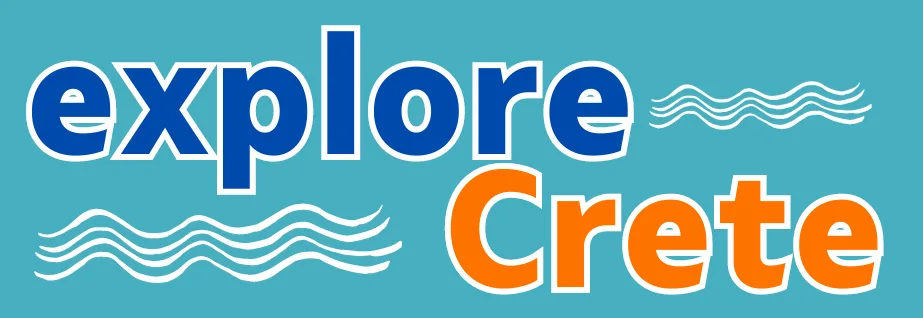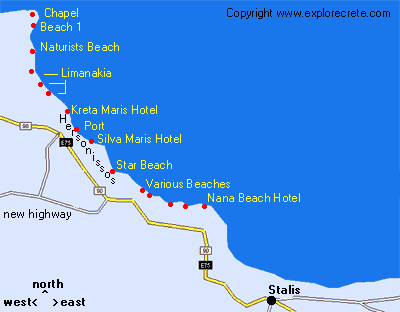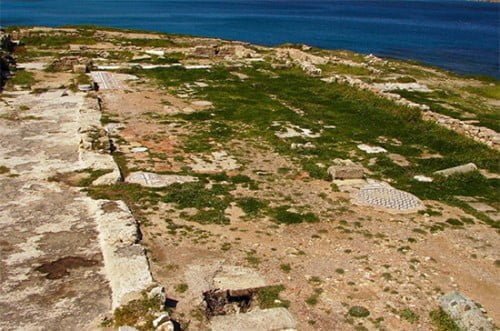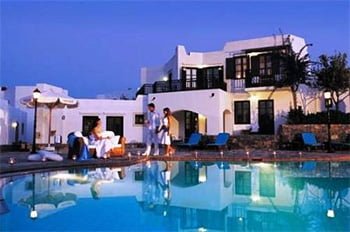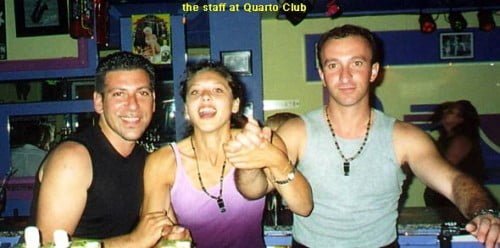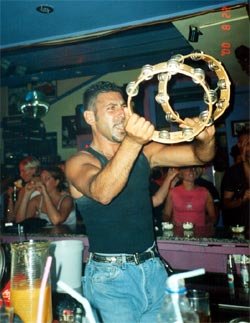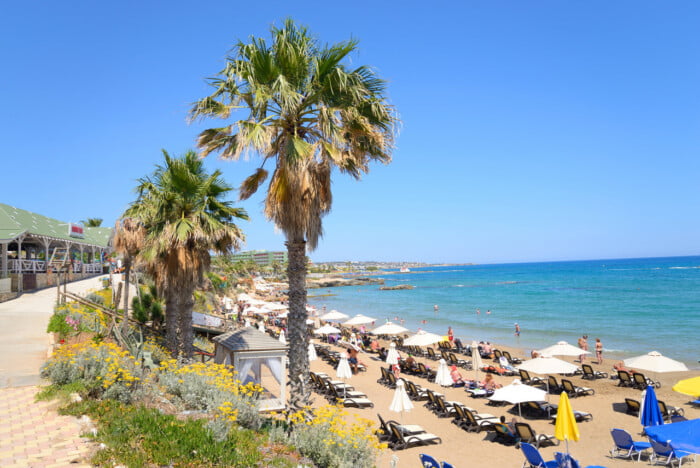Fodele, Crete
About Fodele
Fodele is between Heraklion and Rethymnon, about 27 km west of Heraklion or 50 km east of Rethymnon. It is close to Agia Pelagia, the popular tourist resort on the north coast of Heraklion prefecture.

We take the highway from Heraklion, we drive past the signs to Agia Pelagia and soon after that we see the sandy beach of Fodele with a big hotel built on the side of the hills. We leave the highway and follow the signs to the village of Fodele .
Fodele, the village
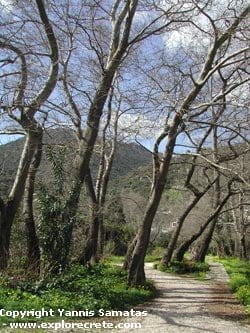
Fodele village is well worth seeing. Fodele is built in an area of orange groves and, according to historians, this was the site of the ancient town of Astali, which was the port of ancient Axos. Today, the people of Fodele may have overdone things with too many craft shops selling the same products, and many cheery tavernas squeezed together, but it remains a central destination for visitors to the area, for two main reasons:
First, Fodele is very green. A very pretty park next to the main square of Fodele offers shade and a picnic site. Even in the beginning of summer there is water running through it, reminding us why this area is so lush and verdant.
We park our car past the huge platanos tree at the main square and we enter the park. We follow the shady path and we start climbing to the older section of Fodele. The route is short and easy and it offers wonderful views across the valley. Unfortunately the views down to the lower newer part of Fodele is not equally charming. For once more we become witnesses of the damage these concrete boxes have done to the landscape of Crete. The houses in the older part of Fodele are old, beautifully decorated with colourful flowers, simple and fitting to their environment. There are also a few new houses here and some of them are beautiful to look at, giving us hope for the future.
Everything grows in the fertile valley of Fodele, and the area is known for good oranges and lemons. During the sunny days of the winter and spring, Fodele is a popular destination for the people of Heraklion and nearby villages for Sunday lunch in the many tavernas here.
The El Greco House and Museum in Fodele
The second reason to stop in Fodele is the El Greco House and Museum.There are plenty of signs showing the way to the Museum, which lies within walking distance, at about 1km from the village centre.
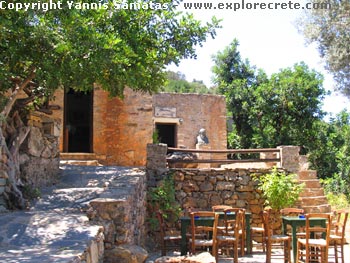
A small collection of memorabilia and some interestingly displayed reproductions are housed in a building dating back to the life of this world-renowned painter and renaissance figure. The collection of reproductions of El Greco’s paintings, split into small rooms, are hung with back-lighting accentuating their own light and colour. They are full of soulful expression and grace. I particularly liked a painting of a young woman, representing Mary Magdelene (1557), her hand across her breast, looking at breaking clouds, is a thing of great beauty.
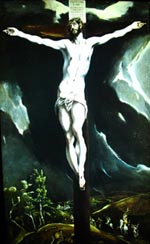
It is said that El Greco (The Greek), or to use his correct name Domenikos Theotokopolous (1541 to 1614) was born here. This son of Crete travelled to Spain, and in Toledo his most important work, with characteristic elongated faces and bold use of light and colour, was completed. Rediscovered by artists in the late 19 th Century, he is considered an influential figure in the development of art in the 20th Century and into our time.
The Museum and the cafe outside open from 9am to 5pm every day apart from Monday. It closes after the summer, at the end of October, to re-open in the spring. Admission is two euros (2005).
The building that houses the El Greco Museum is worth a detour to visit, as is the café outside, in a building of a similar age. This is the site of an earlier settlement which transplanted itself down to the area of the modern Fodele, again as a means to avoid detection by marauding pirates.
Byzantine Churches in Fodele
A little before the El Greco Museum there is the 11th or 12th century Church of Annunciation of the Virgin Mary, with fine frescoes (wall paintings) covering many surfaces, patches remain inside the dome, upon tapering columns, and on the undersides of arches. Larger fragments of saintly figures look upon you with soulful eyes from walls and around the altar.
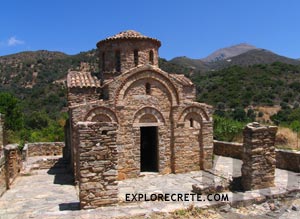
It is a small and highly important relic of the mid-Byzantine period. We were asked not to take interior photographs, as none of the frescoes have yet been published, but a visit here will offer memorable views of icon painting from what many say was a ‘golden era’ for this art form. The opening hours are 8:30 am to 3 pm, apart from Monday when it is closed.
The Monastery of Agios Panteleimon in Fodele
We have time for one last stop, as another pleasant cypress lined road follows the river bed through orange groves, and it brings us to the Monastery of Agios (Saint) Panteleimon, 5 km from Fodele. Built in the last period of the Venetian occupation, it is in complete harmony with the verdant landscape. During the Turkish occupation, the monastery constituted a centre of the revolutionary action and even though it was severely damaged and pillaged, it preserves the traditional architecture of a monastery.
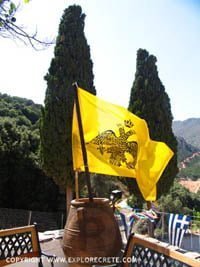
Pronounced Pantel-e-imon, this monastery is dedicated to the patron saint of bakers. We had missed the annual celebration in his honour, sadly, by one day. What remained from the feast were the bunting, alternating Greek flags with those of the two headed Byzantine eagle. You will often see these yellow flags with their black eagle emblem outside churches. The two heads face east and west, symbolising the readiness of Byzantium to deal with threats from either side. The small monastery is closed, although we wait beyond the 4pm time of opening, and can forgive the solitary monk who lives here for any lateness. He must have had his work cut out yesterday, at the feast.
A white walled newer section sits comfortably next to a very old building, the former monastery of Agios Panteleimon. This building is awaiting restoration, but gives an indication of the habitat that monks of the middle-ages would occupy. The young monk here, 23 years old, will have replaced the man now lying under a dignified grave in the courtyard, who died in 2003.
Realizing that we would need to return on another day, we decided to leave Fodele and head back towards Heraklion, the city that looks so placid from up here, in its blue bay, with the sun now low in the sky, and the protecting mountains behind.
© explorecrete.com All Rights Reserved. Reproduction or copying without permission is prohibited.
